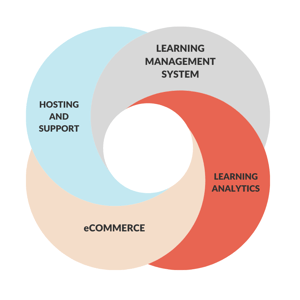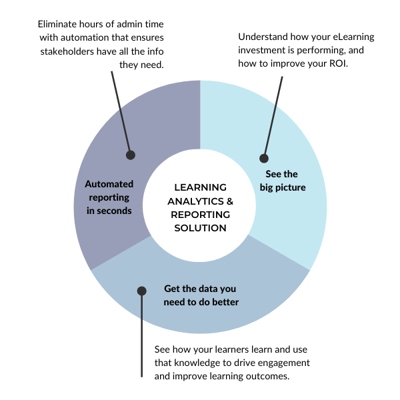Once a futuristic approach to online learning, Learning Management Systems (LMS) are now a central component across HR, training, and administration. The interconnectivity between organizations’ LMS, their revenue centres, and their user data means that when those technologies don’t work together, the result is wasted time, effort, and even unreliable data.
For this reason, LMS integrations can save organizations time and money, by coordinating processes under one system. This post looks into exactly what LMS integrations are, as well as how they can result in cost-savings.
We know a thing or two about this, after all, our experts built the Lambda Suite! This fully-integrated eLearning solution takes all the insights from this article and puts them into action.
 What is LMS integration?
What is LMS integration?
Complete LMS integration is an all-in-one solution that offers organizations the opportunity to combine their eLearning technology under one roof. Capitalizing on the ability of Learning Management Systems to track and organize data, LMS integrations support teams who work at speed and scale, connecting business sectors in terms of their work and communications. LMS integrations can combine: LMS, learning analytics, eCommerce, and hosting and support.
Joining together all the standard features of a Learning Management System with the added benefit of eCommerce and analytics allows organizations to make major upgrades to productivity. Hosting these functions through one provider cuts costs when it comes to the support and maintenance of your system.
See exactly what an integrated eLearning solution looks like in action in this free webinar on Everything You Need to Build Your eLearning Business!
1. Learning Management System Integration
Learning Management Systems are online learning spaces that offer unparalleled accessibility for users and flexibility for course providers. Designed to combine the best of technology, teaching, and study, LMS are used by organizations across the globe to create, deliver, and track a huge variety of training programs. If you want to learn more about the basics of Learning Management Systems, read this blog post: What is LMS? Learning Management Systems in 2019.
2. eCommerce Integration
The ability to sell your eLearning content turns a previously costly investment into a profitable sector of your organization. Integrating eCommerce with an LMS allows truly seamless interaction between learner content and a brand eCommerce platform, which can be fully personalized. By providing one pathway for users from initial interest to the purchase of a course, eCommerce integrations boost user experience, and increase the chances of converting sales.
3. Learning Analytics Integration
Learner Analytics improve on traditional methods of measuring learner performance by harnessing the data-capturing capabilities of a Learning Management System. Integrating the two is therefore the best way to maximize the power of learning analytics and reporting tools. Software such as Lambda Analytics analyze every aspect of the learning process and create reports that represent key performance statistics, as well as avenues for growth and development. Today’s analytics integrations offer users fine-grain, automated reporting, which can be used to highlight skill gaps and make data-driven decisions.
4. Hosting and Support Services
Managing all your technology under one cloud-hosted portal gives users peace of mind when it comes to the running and upkeep of their platform. With unlimited and ongoing support to complement the evolution of your eLearning program, you can deliver a quality experience for learners and admins alike. The addition of true cloud hosting means users can select the right storage solution for their business, all while ensuring the security of client and employee data.
“True Cloud” Hosting? No, it’s not a buzzword! Discover the difference True Cloud Hosting can make for your eLearning!
Why does LMS integration mean cost-savings?
There are essentially two ways a lack of integration can cost you: in the wallet and on the clock:
1. Save Money
- Avoid paying multiple vendors
Consolidation almost always means that a single provider will be less expensive than paying out to multiple vendors for the same functionality.
- Save on support costs
If you have to pay for technical support hours, you want to have a team that’s familiar with your entire technology stack. This way it will be far faster to get any issues resolved as opposed to dealing with multiple teams that are only familiar with a single aspect of your eLearning tech. Faster resolution = lower costs!
- Save on hosting costs
Being able to host all your technology with a single cloud host is - you guessed it - the most cost-efficient option! When you need the best performance, consistent across all aspects of your eLearning programs, pick a hosting vendor that can bring everything together in the cloud (preferably, the True Cloud).
2. Save Time
- Reduce downtime
Having a dedicated support team that’s familiar with every aspect of your eLearning technology means faster resolution of issues and less downtown, resulting in happier users and admins!
- Save on implementation time
Echoing above, an implementation team experienced with LMS integrations can eliminate technical bottlenecks and get your systems running up and running much quicker, and keep them rolling smoothly, when things are designed to work together.
- Streamline...everything!
Integrating your systems delivers a consistent user experience for everyone involved with your eLearning, eliminating administrative headaches and delivering an efficient and effective learning environment.
At the end of the day, why pay more people more money to deliver the services you’re already using? The best way to keep your LMS costs low is to pick a single vendor that can deliver an integrated eLearning environment that meets all your needs.
Want to learn more about Managing LMS Costs and How To Make Cost-Saving eLearning Decisions? We’ve got you covered with this white paper!
Whether you’re looking to implement cost-saving integrations for your Learning Management System, are looking to optimize your LMS and eLearning programs with learning analytics, or need any other eLearning revenue solutions, we have the expertise to help you reach your goals.
Contact us today. We’d love to help you create a better way to learn!
Other resources you might be interested in:





